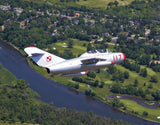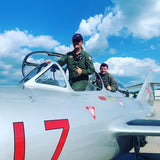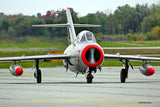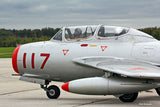Aircraft Type History
In 1948, the Soviet MiG design bureau developed a high-performance jet fighter design called the I-310. It incorporated some advanced features, such as a 35-degree wing sweep, and it promised to be a sprightly performer. However, the design lacked one essential component: a suitable engine. This problem was resolved when the British government authorized the Rolls-Royce company to export their Nene turbojet engine to Russia. As soon as the Russian Klimov design bureau received the engines, they immediately developed their own copy of the Nene, called the Klimov RD-45. Within months, the first prototype of the I-310 had flown with the new engine. The aircraft was re-designated MiG-15 and entered service early in 1949.
Later in the year, the improved MiG-15bis version appeared and a two-seat trainer version, the MiG-15UTI, was also introduced. In 1950, Western air forces were surprised at the combat capability of the new design in the skies over Korea. The MiG-15 could out-climb, out-turn, and fly higher than the US-built F-86 Sabre. Fortunately, Allied pilots were better-trained and had better equipment installed in their aircraft, and they prevailed against the MiG.
The MiG-15 was eventually built under license in Czechoslovakia as the A-102, S-102, and two-seat CS-12; and in Poland as the LIM-1, LIM-2, and two-seat LIM-3 and SBLim-2. China also built many components of the airplane. As would be expected, many Warsaw Pact nations used the MiG-15, and after the introduction of the MiG-17 and MiG-19, the MiG-15 was retired as a fighter and became the standard advanced trainer of the Eastern Bloc. During its production run, over 17,000 MiG-15 variants were built by Warsaw Pact countries.
Our MiG-15’s History
Waterloo Warbird’s MiG-15 (serial number 1A10017) was built in 1954 and started its life as a single-seat aircraft. After entering service in Poland it was eventually converted to a two-seat trainer (SBLim-2, also categorized as a MiG-15 UTI) and powered by a Klimov VK-1A jet engine of over 5900 pounds of thrust. Our MiG served in this capacity until being retired in February of 1992, a remarkably long military career for a single-engined jet. It was then purchased by a company in the United States and was dismantled and shipped to Pennsylvania in 1993. It was issued registration N15LC and finally flew again in 1998. In 2009, the MiG was purchased by Viper North and the registration changed to N15VN. Viper North brought the MiG to Canada in 2013 and she soon thereafter became a member of our Waterloo Warbird fleet as C-FMVN.
Extensive maintenance has occurred in the years since, including a major rebuild of the braking system, replacing the old brakes with those normally installed in a T-33. This will allow for consistent stopping on shorter runways. C-FMVN, or “Natasha” as she has become known, finally took to the air again in late fall of 2018 and is destined to become a crowd favourite for years to come, as there are very few MiG-15s left flying. A flight in Natasha would be the penultimate in classic fighter jet experience for anyone!
Your Flight Experience Day
The Technical Stuff
General Characteristics
- Crew: one/two
- Length: 10.11 m (32 ft 2 in)
- Wingspan: 10.085 m (33 ft 1 in)
- Height: 3.7 m (13 ft 1.7 in)
- Empty weight: 3724 kg (8208 lb)
- Max. takeoff weight: 6045 kg (13327 lb)
- Powerplant: 1 × Klimov VK-1 Tubojet, 26.5 kN (5950 lb)
Performance
- Maximum speed: 1015 km/h (548 kn, 630 mi/h)
- Service ceiling: 14625 m (47970 ft)
Armament
- Canon: 1x NR-23 23mm Canon w/ 80 Rounds
- Flares: Electronically operated w/ red, green, white and yellow flares
- Wing Hardpoints: 2x 100kg (220lb) bombs, drop tanks, or unguided rockets













